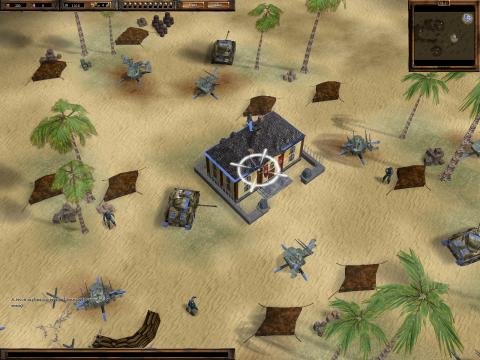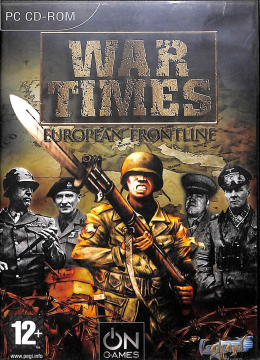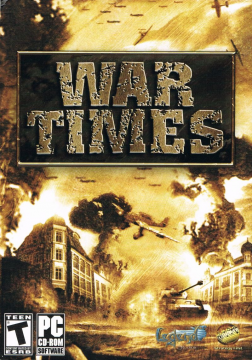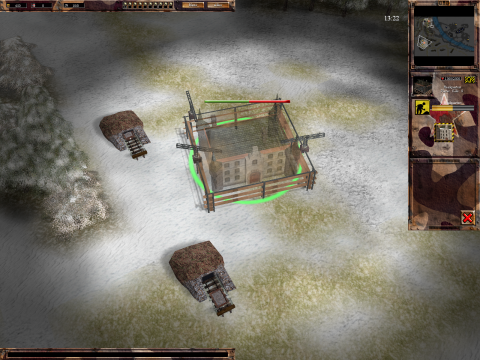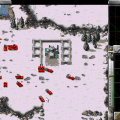World War II is a popular backdrop for video games of all genres, especially in the strategy department. Most of these tend to be turn-based or fall into the real-time tactics category, whereas real-time strategy titles with base building and resource gathering are somewhat uncommon. However, there are some exceptions, among them War Times: European Frontline, created by Spanish developer Legend Studios LD and published by Strategy First.
As the names implies, War Times: European Frontline, focuses on the European theater of World War II, with the playable factions being Germany, the United Kingdom, the United States, and the Soviet Union. The North American release, merely titled War Times, makes this less clear. War Times: European Frontline offers 32 missions spread over two campaigns as well as a downloadable bonus mission. Multiplayer and skirmish matches are available too.
The concept of War Times: European Frontline does not stray far from real-time strategy formulae established in the 90s. The core of every base forms the headquarters, which produces worker units. Said workers gather minerals from mines and haul oil from oil wells. Both of these resources are then used to construct buildings to increase the population limit, produce units, or research new technologies.
Though the four factions cover the same basics – all of them have access to infantry, planes, and tanks, and share the same basic structures – there are some notable differences between them.The Germans start with access to the vicious flamethrower infantry. Slower than their basic MG soldier, flamethrower infantry deals splash damage and torches buildings in quick fashion. Early during a match, other factions might have trouble countering this unit properly.
Equally destructive is the German diver bomber. It is only slightly more expensive than the common bomber but delivers bombs that are as precise as there are lethal. Lastly, German has access to the King Tiger, Nazi Germany’s iconic heavy tank, and the Leopold. The Leopold artillery is the game’s longest-ranged artillery piece. Historically, only about two dozen were built and they required rails to be moved. War Times: European Frontline does away with such petty restrictions and allows them to travel on any terrain.
The United Kingdom has mortar soldiers instead of flamethrowers– a counter to light vehicles. Also trained in their barracks is the spy, a reconnaissance unit with a ridiculous number of upgrades – so many, in fact, that it is generally more efficient to just send a basic rifleman into the fog of war and have him reveal parts of the enemy positions before he gets inevitably shot.
Equally upgrade-heavy is the Avro Lancaster, the heaviest bomber in War Times: European Frontline. The Lancaster decimates enemy buildings in no time – and it better do, because getting all the necessary upgrades and actually building one takes forever. Also of interest is the British naval yard. It produces a transport vessel and allows the British to transport vehicles over water, and they are the only faction that can do this. The Americans and Germans have to rely on parachute drops whereas the Soviets have an aquatic infantry unit.
The United States are the most average faction, which is not necessarily a bad thing. Neither are their vehicles and planes are particularly strong, nor do they suffer any specific weakness. The one exception is the American elite infantry. Stronger than most other infantry units – especially once it has all it upgrades – elite infantry is a force to reckon with. Unfortunately, getting their takes so long that the opposition is likely to have a counter at hand. Thus, it is better for an American player to rely on trusty Shermans instead.
The Soviets are distinct from the other factions by the way their construct their buildings. All other factions can only construct new buildings within a certain radius around their headquarters. The headquarters itself is the only building that can be erected anywhere on the map, provided the fog of war has been lifted there first. In order to expand, more expensive and slow-to-raise headquarters need to be build. The Soviets have no such restriction. Their buildings can be raised anywhere where the player has vision.
This does not only break certain campaign missions, but also gives the Soviets a huge advantage in multiplayer matches, as their can forward their unit production with ease. Additionally, the USSR has elite infantry that can swim as well as the K2, the best anti-tank vehicle in War Times: European Frontline. They are also the only faction with a repair vehicle and do not have to rely on the rather slow health regeneration alone.
While the four factions are quite diverse, War Times: European Frontline multiplayer matches are not. Germany only stands a chance if they rush the opposition. The Soviets are likely to win if they play out their build-anywhere advantage. The Americans and British stand no chance with their weak low-tier units. If the match does not reach its conclusion within the first couple of minutes, it is likely to become a slog. The reason for this are the highly efficient guard towers. Each faction’s guard tower has slightly different attributes, but they all work the same: once placed on the map, they machine-gun everything that comes into sight. By itself, this is not an issue. However, the guard tower is way too effective. A single tower is quick and cheap to build, but can absorb an ungodly amount of infantry. Even light vehicles stand no chance.
Thus, once a player has walled themselves in, planes or medium tanks are needed to break their defenses. Considering how long it takes to get access to those, the match is likely to become an agonizingly slow affair. Equally poorly balanced are the high-tier heavy units. A single King Tiger, Churchill Mk. IV or K2 can eat a dozen lighter vehicles while barely taking a scratch. Full balance is a difficult thing to achieve in a real-time strategy games (especially one with four factions), but in War Times: European Frontline, everything is either made of tungsten steel or wet tissue paper. There is simply no middle ground.
The inter-faction balance is even worse in some other aspects. The British can lay mines, a lethal obstacle for all but the heaviest of vehicles. The Soviets have a specialist that can clear them out. The Germans and Americans do not, and their only option to clear mine fields is to send units into them. They also lack any means to detect said mines.
With the multiplayer aspect being incredibly poorly balanced, most players will likely turn to the singleplayer campaign War Times: European Frontline offers. The first campaign is the Axis campaign with only ten missions. The reason for this is the game’s design philosophy: only battles actually won by Germany are part of the Axis campaign. The Invasion of Poland makes the start, followed by the Battle of France, the Battle of Britain, some missions in North Africa as well as a single mission in the USSR, before the campaign unceremoniously ends after Operation Market Garden. Every mission starts with a briefing and animated maps that show the progress of the war. The briefings are a bit of an odd mix. Some sound highly dramatic, others just list divisions and regiments in sober fashion. Nevertheless, they add a sense of drama and tension combined with the few animated cutscenes.
The lengthy Allied campaign features twenty-two missions. It starts with the war in Western Europe, moves on to the Eastern Front and North Africa, and ends with the Western Allies and the USSR advancing on Germany from both sides. In the final mission, Berlin is conquered by the Soviets – a somewhat satisfying conclusion. Additionally, the developers released an alt-historical bonus mission in which Germany conquers Gibraltar with the help of Francoist Spain.
Overall, the missions are a decent mix between the usual suspects such as the Invasion of Normandy and some lesser-known battles such as the Battle of Hürtgen Forest. Of note is one of the later Allied mission in which the Buchenwald concentration camp is liberated. As a general rule, games keep their hands off Nazi concentration camps and the Holocaust, but the developers of War Times: European Frontline apparently had no such inhibitions.
Though almost every mission in War Times: European Frontline is based on a historical battle, the developers took great liberties when they designed the maps and objectives – the German battleship Bismarck is sunken years too early, Rommel and his personal tank needs rescuing from a horde of British armor, the war in North Africa is won in the air, and at one point the Soviets have to prevent a bizarre artillery attack on the Yalta Conference. Equally bizarre is the combinations of assets used for the map. Many of them look like a wasteland, even the ones not set in the North African desert. A map set in the Netherland has a German fortified base next to cliché windmills and blooming tulip – in September, no less. Other maps simply look plain and boring, with almost no interesting features. War Times: European Frontline is often depressingly brown and grey, even for a game from the early 2000s. Likewise, the soundtrack and sound effects are serviceable, but nothing special.
The mission design, on the other hand, is rather colorful. In many missions, all one needs to do is to destroy the enemy, but in others, War Times: European Frontline gives the player a variety of objectives. There are rescue missions, missions in which specific structures need to be destroyed, tactical missions with no base, a mission during the Battle of Britain that is entirely air-based, and more. Despite this variety, War Times: European Frontline is not always exciting due to its poor pacing. Many of the missions with base constructions start the player with no structures and little resources. The first order is to raise a headquarters, which takes several minutes. The AI generally does not attack the player during this initial phase of the battle and instead builds up a larger force to swarm them with later. Thus, all the player does is watch the headquarters’ progress bar fill up slowly.
Exploration during this phase is possible, but rarely necessary. Mines and oil wells are visible through the fog of war, indicating where the enemy base is. After the headquarters has finally been established, resources need to be gathered. With no supply depots available, only ten workers are available. These slowly gather resources, which are then used to slowly build more of them, slowly build depots to raise the population limits, and then the actual base can finally be build. Buying upgrades and building high-tier units also takes forever. It is not uncommon to spend half an hour just sitting there, waiting for progress bars to progress, only to end up decimating the enemy base in five minutes with some overpowered piece of military hardware. Sometimes it is even beneficial to destroy all starting troops in order to free unit slots.
Thankfully, not all missions are like this. A positive counterexample is one of the Allied missions in North Africa. The British have to defend their position against an onslaught of German troops. Resources are limited, and as the British defenses slowly crumble, the situation becomes tense and the mission exciting – until the Germans spontaneously start sending planes. Without prior knowledge of this aerial menace, the base is all but lost. Other missions suffer from similar issues. In the final phase of the Battle of Berlin, a group of King Tigers attacks the player. Only the Soviet K2 is strong enough to stop them, and if none of them have been built until that point, the mission becomes almost impossible to win. However, poor mission design sometimes works in the player’s favor.
At one point, the Soviets are tasked with the destruction of two V2 missile launch sites. The launch sites are surrounded by mountains. While being under a constant barrage of missiles, the Soviets have to build airfields, fuel up their planes, and take out the launch sites. Or they can just build a barracks next to the missiles, train a couple of riflemen, and blow up the sites swiftly and unceremoniously. It seems that whoever designed this map forgot about the Soviets’ special ability. Other questionable design choices are of more technical nature. Upgrades are often available when the unit to receive them is not, the tech tree is all over the place, and some tactical missions throw overpowered units at the player, encouraging them to exploit War Times: European Frontline’s scripts and mission triggers.
War Times: European Frontline is unbalanced, ugly, and poorly paced. However, it is also quite creative in some regards, mixes up the real-time strategy formula a bit and tries to makes its campaigns interesting and its factions diverse. It does not always succeed, but remains an interesting game and one of the few World War II real-time strategy titles that do not stray into the territory of real-time tactics.

